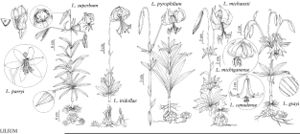Difference between revisions of "Lilium michiganense"
Bull. Torrey Bot. Club 42: 353. 1915.
FNA>Volume Importer |
imported>Volume Importer |
||
| (5 intermediate revisions by 2 users not shown) | |||
| Line 8: | Line 8: | ||
}} | }} | ||
|common_names=Michigan lily | |common_names=Michigan lily | ||
| + | |special_status={{Treatment/ID/Special_status | ||
| + | |code=F | ||
| + | |label=Illustrated | ||
| + | }}{{Treatment/ID/Special_status | ||
| + | |code=E | ||
| + | |label=Endemic | ||
| + | }} | ||
|basionyms= | |basionyms= | ||
|synonyms={{Treatment/ID/Synonym | |synonyms={{Treatment/ID/Synonym | ||
|name=Lilium canadense subsp. michiganense | |name=Lilium canadense subsp. michiganense | ||
|authority=(Farwell) B. Boivin & Cody | |authority=(Farwell) B. Boivin & Cody | ||
| + | |rank=subspecies | ||
}} {{Treatment/ID/Synonym | }} {{Treatment/ID/Synonym | ||
|name=Lilium canadense var. umbelliferum | |name=Lilium canadense var. umbelliferum | ||
|authority=(Farwell) B. Boivin | |authority=(Farwell) B. Boivin | ||
| + | |rank=variety | ||
}} {{Treatment/ID/Synonym | }} {{Treatment/ID/Synonym | ||
|name=Lilium michiganense var. umbelliferum | |name=Lilium michiganense var. umbelliferum | ||
|authority=Farwell | |authority=Farwell | ||
| + | |rank=variety | ||
}} {{Treatment/ID/Synonym | }} {{Treatment/ID/Synonym | ||
|name=Lilium michiganense var. uniflorum | |name=Lilium michiganense var. uniflorum | ||
|authority=Farwell | |authority=Farwell | ||
| + | |rank=variety | ||
}} | }} | ||
|hierarchy=Liliaceae;Lilium;Lilium michiganense | |hierarchy=Liliaceae;Lilium;Lilium michiganense | ||
| Line 49: | Line 60: | ||
-->{{#Taxon: | -->{{#Taxon: | ||
name=Lilium michiganense | name=Lilium michiganense | ||
| − | |||
|authority=Farwell | |authority=Farwell | ||
|rank=species | |rank=species | ||
| Line 63: | Line 73: | ||
|publication title=Bull. Torrey Bot. Club | |publication title=Bull. Torrey Bot. Club | ||
|publication year=1915 | |publication year=1915 | ||
| − | |special status= | + | |special status=Illustrated;Endemic |
| − | |source xml=https:// | + | |source xml=https://bitbucket.org/aafc-mbb/fna-data-curation/src/2e0870ddd59836b60bcf96646a41e87ea5a5943a/coarse_grained_fna_xml/V26/V26_330.xml |
|genus=Lilium | |genus=Lilium | ||
|species=Lilium michiganense | |species=Lilium michiganense | ||
Latest revision as of 21:14, 5 November 2020
Bulbs usually yellowish, rhizomatous, unbranched, 1.6–5.8 × 4.9–14.1 cm, 0.3–0.5 times taller than long, 2 years’ growth evident as annual bulbs, scaleless sections between these 2.6–6.2 cm; scales unsegmented, longest 1–3 cm; stem roots present or absent. Stems to 1.9 m. Buds rounded in cross section. Leaves in 4–12 whorls or partial whorls, 3–13 leaves per whorl, ± horizontal or ascending in sun, drooping at tips, 4.6–15.3 × 0.6–2.3 cm, 3.5–13.7 times longer than wide; blade narrowly elliptic, occasionally linear or slightly lanceolate, margins not undulate, apex acute, acuminate in distal leaves; principal and some secondary veins impressed adaxially, veins and margins noticeably roughened abaxially with tiny ± deltoid epidermal spicules, especially on proximal leaves. Inflorescences racemose, 1–11-flowered. Flowers ± pendent, not fragrant; perianth Turk’s-cap-shaped; sepals and petals reflexed 1/4–2/5 along length from base, yellow-orange or sometimes orange-yellow or orange proximally, red-orange distally, with maroon, often large spots, red-orange or occasionally red or orange-red abaxially, not distinctly clawed; sepals not ridged abaxially, 5.5–9.3 × 1.2–2 cm; petals 5.3–9.1 × 1.5–2.2 cm; stamens moderately exserted; filaments parallel at first, then ± widely spreading, diverging 13°–23° from axis, pale yellow-green; anthers magenta or occasionally pink-magenta, 0.6–1.3 cm; pollen orange-rust, sometimes orange, rust, or rust-brown; pistil 3.4–6.5 cm; ovary 1.5–2.9 cm; style red entirely or only distally; pedicel 11–22 cm. Capsules 2.8–5 × 1.5–2.6 cm, 1.4–2.8 times longer than wide. Seeds not counted. 2n = 24.
Phenology: Flowering summer (mid Jun–Jul).
Habitat: Tallgrass prairies, streamsides, swamps and bottoms, moist woodland edges, lakeshores, ditches along roads and railways, often calciphilic
Elevation: 100–600 m
Distribution

Ont., Ark., Ill., Ind., Iowa, Kans., Ky., Mich., Minn., Mo., Nebr., N.Y., Ohio, Okla., S.Dak., Tenn., Wis.
Discussion
B. Boivin and W. J. Cody (1956) proposed uniting Lilium michiganense and L. superbum as subspecies of L. canadense on the basis of overall similarity, though it is now well accepted that L. superbum does not belong there. There can be little doubt as to the close relationship between L. michiganense and L. canadense, however, and vegetatively the two are often indistinguishable. Hybrid intermediates occur across a wide band where the distributions meet in central Ohio and northwestern New York (R. M. Adams and W. J. Dress 1982). It would not be unreasonable to include L. grayi and treat them as subspecies, but floral differences among the three are comparable to those between other species in the genus.
Farwell’s proposed varieties uniflorum and umbelliferum were described from young plants with single flowers and umbellate inflorescences respectively, but young plants with these characteristics are found throughout the range of this species.
Plants examined from east-central Tennessee (e.g., Wayne and Coffee counties) that were previously referred to Lilium michiganense are L. superbum in some cases, in others L. canadense perhaps introgressed with L. michiganense.
The Michigan lily often co-occurs in tallgrass prairies with Lilium philadelphicum; here as everywhere it usually blooms much later. However, it flowers earlier than L. canadense where their ranges are contiguous in Ohio (E. L. Braun 1967).
Lilium michiganense is pollinated primarily by swallowtail butterflies; in the southern part of its range these include the pipevine [Battus philenor (Linnaeus), family Papilionidae]. Great spangled fritillaries [Speyeria cybele (Fabricius), family Nymphalidae] also visit this species and carry its pollen, though it is unlikely that this brushfooted butterfly is a major pollinator.
Selected References
None.
